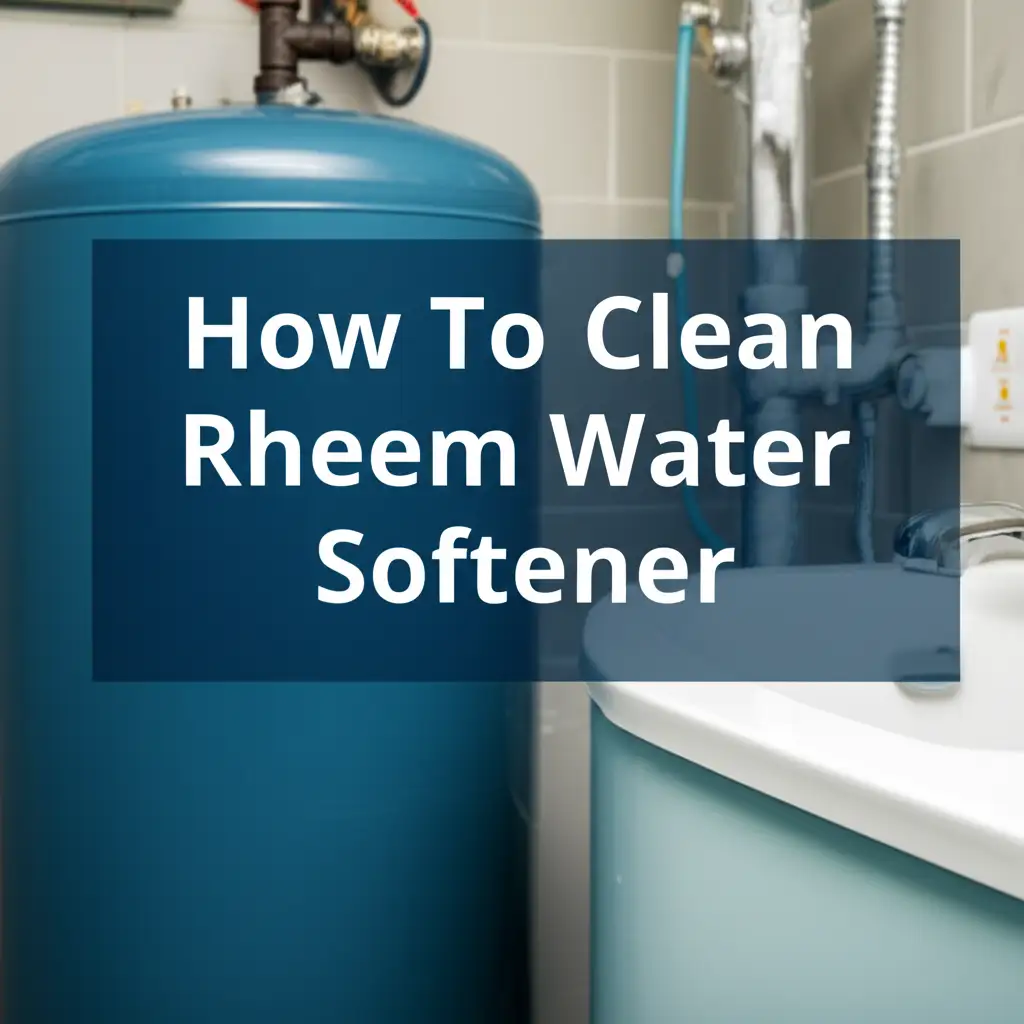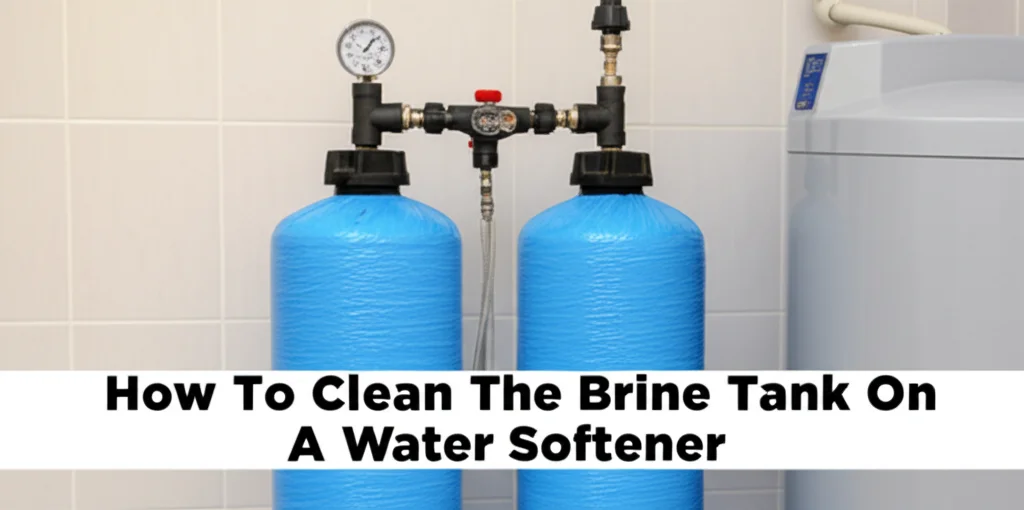· Home Maintenance · 12 min read
How To Clean Rheem Water Softener

How To Clean Your Rheem Water Softener for Peak Performance
Hard water issues can be a real headache. I know because I have dealt with spotty dishes, stiff laundry, and scale buildup in my appliances. A Rheem water softener works hard to protect your home from these problems. Regular cleaning keeps your system running efficiently. This guide shows you exactly how to clean a Rheem water softener, ensuring it provides soft water for years to come. I will walk you through the necessary tools, a step-by-step cleaning process, and essential maintenance tips. Let’s make sure your water softener performs its best.
Takeaway:
- Regularly clean your Rheem water softener’s brine tank to prevent salt bridges and sediment buildup.
- Use specialized resin cleaner to refresh the resin bed, ensuring optimal ion exchange.
- Address common issues like salt bridges and iron deposits promptly to maintain system efficiency.
To clean a Rheem water softener, bypass the unit, empty and scrub the brine tank with soap and water, flush thoroughly, and then use a specialized resin cleaner during a regeneration cycle. This process removes buildup and ensures the system processes hard water effectively.
Why Cleaning Your Rheem Water Softener Matters
Maintaining your Rheem water softener is very important. It directly affects the water quality in your home. Over time, your water softener can accumulate various deposits. These deposits include salt residue, sediment, and even iron particles. These buildups can reduce the softener’s efficiency. They can also lead to more hard water issues.
A dirty softener might struggle to remove minerals from your water. This means you will still see hard water spots on your dishes. Your laundry might feel stiff, too. Appliances like dishwashers and water heaters could suffer. Buildup inside the softener itself can damage internal components. This could lead to expensive repairs later on.
Regular cleaning helps your Rheem system last longer. It ensures the resin beads can effectively exchange ions. This keeps your water truly soft. Cleaning also prevents unpleasant odors. Sometimes, bacteria can grow in stagnant areas within the tank. Proper cleaning eliminates these issues. It guarantees clean, soft water for all your household needs.
Tools and Materials Needed for Rheem Water Softener Cleaning
Before you start cleaning your Rheem water softener, gather all the necessary items. Having everything ready makes the process smoother. You do not want to stop midway to find a tool. This list ensures you are fully prepared for the task.
Here are the tools and materials I recommend:
- Large bucket or wet/dry vacuum: You will need this to remove water and salt from the brine tank. A wet/dry vacuum makes the job much easier and faster.
- Stiff brush with a long handle: This brush helps you scrub the inside of the brine tank. Make sure it can reach the bottom and sides.
- Mild dish soap or bleach: A small amount of dish soap works well for general cleaning. For disinfection, a diluted bleach solution (1/4 cup bleach per gallon of water) is effective.
- Garden hose or another water source: You need this for rinsing the brine tank thoroughly. Ensure you can reach the softener with the hose.
- Rheem-approved resin cleaner: This is crucial for cleaning the resin bed. There are different types, like iron removers or general resin cleaners. Choose one compatible with your Rheem unit.
- Towels or old rags: These are useful for wiping up spills. Spills can happen, so be ready for them.
- Flashlight (optional but helpful): A flashlight allows you to see inside the brine tank better. This helps you identify any stubborn buildup.
Having these items ready saves you time and effort. It ensures a complete and effective cleaning process for your water softener.
Step-by-Step Guide to Cleaning the Brine Tank
Cleaning the brine tank is an important first step. This tank holds the salt that regenerates the resin. Sediment and salt buildup here can hurt performance. Follow these steps carefully for a thorough cleaning.
First, you need to bypass your Rheem water softener. Find the bypass valve, usually located at the back of the unit. Turn the handle or pull the knob to move it into the bypass position. This stops water flow into the softener. This step prevents water from entering the house untreated during cleaning. It also allows you to work safely without water pressure.
Next, remove the brine tank lid. Look inside. If there is water, use your wet/dry vacuum or a bucket to remove it. You also need to remove any remaining salt. Scoop out what you can, then vacuum or bail out the rest. You will likely find a layer of sludge or dissolved salt at the bottom. This is normal but needs cleaning. If you have been seeing issues like water spots after washing dishes, this buildup could be the cause. Similar issues can arise with other water systems, like when you need to clean sediment from water lines.
After removing water and salt, it is time to scrub. Mix a small amount of mild dish soap with warm water in a bucket. Dip your stiff brush into the soapy water. Vigorously scrub the inside walls and bottom of the brine tank. Pay attention to any dark stains or slimy residue. These indicate mineral or bacterial growth. If you choose to use a bleach solution for sanitization, use it after the initial scrub. Pour the diluted bleach solution into the tank and scrub again, ensuring all surfaces are covered.
Finally, rinse the brine tank completely. Use your garden hose to spray down the inside. Flush out all soap, bleach, and loose debris. Keep rinsing until the water runs clear. A complete rinse is important. You do not want any cleaning agents left in the tank. Once clean, reposition the tank and fill it with fresh softener salt. Return the bypass valve to the “service” position. Your brine tank is now ready to support effective regeneration.
How to Clean the Resin Bed in Your Rheem Water Softener
The resin bed is the heart of your water softener. It performs the actual ion exchange. Over time, the resin beads can become fouled. Iron, manganese, and other minerals can coat them. This reduces their ability to soften water. Regular resin cleaning is essential.
You will need a specialized resin cleaner for this task. Rheem often recommends specific types or brands. These cleaners are formulated to remove deposits from the resin without damaging it. Read the instructions on your chosen resin cleaner carefully. Some are liquid, others come in powder form. The amount you need also varies. Using the correct cleaner and amount is vital for safety and effectiveness.
Most resin cleaners are added directly to the brine tank. For a liquid cleaner, you might pour it into the brine well. This is a narrow tube inside the brine tank. For powder, you might dissolve it in water first. The cleaner then gets drawn into the resin tank during a regeneration cycle. The cleaner works by dissolving the mineral buildup on the resin beads. This process is similar to how you might clean sediment from a water heater to improve its efficiency.
Once the cleaner is in the brine tank, you need to initiate a manual regeneration cycle. Consult your Rheem water softener’s manual for instructions on how to do this. This cycle will draw the cleaning solution through the resin bed. The cleaner saturates the resin, breaking down the mineral deposits. The regeneration process then flushes these contaminants out of the system. This usually goes down the drain line. The whole process revitalizes the resin. It restores its capacity to remove hardness minerals. This step is key to getting truly soft water again.
Addressing Common Rheem Water Softener Issues (Salt Bridges, Sediment)
Rheem water softeners are reliable. However, certain common issues can affect their performance. Two frequent culprits are salt bridges and sediment accumulation. Understanding how to handle these problems keeps your softener running smoothly. I have seen these problems many times.
A “salt bridge” occurs when salt in the brine tank hardens into a solid mass. This bridge forms above the water level. The salt below the bridge cannot dissolve into the water. As a result, the softener cannot create brine for regeneration. Your water will start to feel hard. You might notice this when you wash your hands or take a shower. The solution is simple: break the bridge. Take a broom handle or a long stick. Gently push down on the salt mass. Break it apart. Do not push too hard, as this could damage the brine tank. Once the bridge breaks, the salt can dissolve again. The softener will then be able to regenerate properly.
Sediment is another common issue. Fine particles, rust, or dirt can enter your brine tank with the salt. They can also come from your main water supply. Over time, this sediment settles at the bottom of the tank. It can clog the brine well. This prevents brine from being drawn into the resin tank. You might notice the softener not using salt. Your water may also not be as soft as it used to be. Cleaning the brine tank, as described earlier, is the best way to remove this sediment. Regularly checking the salt you add also helps. Make sure it is clean and pure. If you have well water, installing a sediment pre-filter can prevent many of these issues. This is similar to adding a filter when you clean water lines from a well to ensure cleaner water.
Iron deposits also pose a significant challenge. If your water has a high iron content, it can coat the resin beads. This makes them less effective. Specialized iron-removing resin cleaners are available. These cleaners are stronger. They specifically target iron stains on the resin. You use them during a regeneration cycle, just like other resin cleaners. Consistent use of these cleaners can prevent severe iron fouling. Addressing these common issues ensures your Rheem water softener continues to deliver soft water.
Regular Maintenance Tips for Your Rheem Water Softener
Cleaning your Rheem water softener is part of a larger maintenance routine. Consistent care extends its lifespan and ensures peak performance. I always tell people that prevention is better than cure. These tips help you avoid major issues and keep your water soft.
First, check your salt levels regularly. I make it a habit to check mine once a month. The salt level should always be above the water line, preferably at least halfway full. Allowing the salt to run out completely means your softener cannot regenerate. This results in hard water. Use high-quality salt. Look for salt that is 99.5% pure or higher. Avoid using rock salt, as it can contain impurities that lead to more sediment.
Next, routinely inspect your brine tank. I look for salt bridges every few months. A quick visual check can identify a problem early. If I see a crust forming, I break it up immediately. This simple act saves a lot of hassle. Also, check for any unusual odors. A sulfur smell could indicate bacterial growth. This means it is time for a thorough cleaning and sanitization.
Periodically, check the system settings. Your Rheem water softener has various settings. These include hardness levels and regeneration times. If your water needs change, adjust these settings. For example, if more people move into your home, you might need to increase the regeneration frequency. Make sure the date and time settings are correct on the control panel. Incorrect settings can cause the softener to regenerate at inefficient times. This wastes water and salt.
Finally, consider a pre-filter. If your water supply has a lot of sediment, a whole-house sediment filter installed before the softener can be very beneficial. This filter catches larger particles before they reach your softener. This reduces the sediment load in your brine tank and protects the resin bed. It is a proactive step that can extend the life of your softener. Just like cleaning your fridge water line prevents clogs, maintaining your main water source is key to overall system health.
When to Call a Professional for Your Rheem Water Softener
While much of water softener maintenance is DIY-friendly, some issues require professional help. Knowing when to call an expert can save you time, effort, and potentially prevent further damage. I always recommend calling a professional if you are unsure. It is better to be safe than sorry.
If your Rheem water softener is not producing soft water after regular cleaning and troubleshooting, it is time for a professional assessment. This includes situations where salt is being consumed but water remains hard. Or perhaps the system regenerates constantly but still fails to soften water. These symptoms suggest a deeper problem. It could be a faulty valve, a damaged control board, or a completely fouled resin bed that your cleaning cannot fix. A technician has specialized tools and diagnostic equipment. They can pinpoint the exact cause of the problem.
Unusual noises coming from the unit are another warning sign. Clunking, grinding, or loud hissing sounds during operation suggest internal mechanical issues. These parts often require specialized knowledge and tools to repair. Trying to fix them yourself might void your warranty. It could also cause more damage. It is safer to let a trained technician handle internal component repairs.
Visible leaks are also a serious concern. A small drip might be manageable with a simple tightening. However, persistent leaks from the control head or major plumbing connections need immediate professional attention. Water damage can be expensive. Leaks also indicate potential internal pressure issues or cracked components. A professional can identify the source of the leak and make the necessary repairs.
Finally, if you suspect issues with the resin bed that go beyond simple iron fouling, call an expert. For example, if the resin beads are breaking down or are completely exhausted. Replacing the resin is a complex job. It involves specialized equipment and disposal procedures. A professional ensures the new resin is installed correctly. They also make sure the system is properly charged and sanitized. Trusting a professional with these complex tasks protects your investment and ensures your Rheem water softener
- Rheem water softener cleaning
- water softener maintenance
- clean brine tank
- clean resin bed
- hard water solutions




